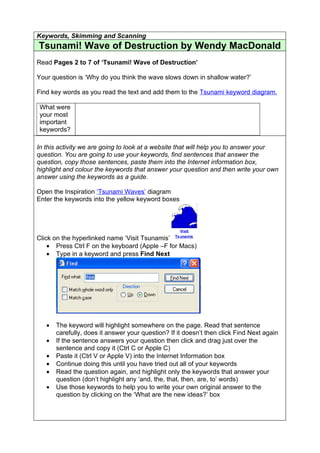
Tsunami students interactive worksheet
- 1. Keywords, Skimming and Scanning Tsunami! Wave of Destruction by Wendy MacDonald Read Pages 2 to 7 of ‘Tsunami! Wave of Destruction’ Your question is ‘Why do you think the wave slows down in shallow water?’ Find key words as you read the text and add them to the Tsunami keyword diagram. What were your most important keywords? In this activity we are going to look at a website that will help you to answer your question. You are going to use your keywords, find sentences that answer the question, copy those sentences, paste them into the Internet information box, highlight and colour the keywords that answer your question and then write your own answer using the keywords as a guide. Open the Inspiration ‘Tsunami Waves’ diagram Enter the keywords into the yellow keyword boxes Visit Click on the hyperlinked name ‘Visit Tsunamis’ Ts unamis • Press Ctrl F on the keyboard (Apple –F for Macs) • Type in a keyword and press Find Next • The keyword will highlight somewhere on the page. Read that sentence carefully, does it answer your question? If it doesn’t then click Find Next again • If the sentence answers your question then click and drag just over the sentence and copy it (Ctrl C or Apple C) • Paste it (Ctrl V or Apple V) into the Internet Information box • Continue doing this until you have tried out all of your keywords • Read the question again, and highlight only the keywords that answer your question (don’t highlight any ‘and, the, that, then, are, to’ words) • Use those keywords to help you to write your own original answer to the question by clicking on the ‘What are the new ideas?’ box
- 2. Why do you think the wave slows down in shallow water? My Answer was Meanings of words Sometimes when you are reading a book there are some words that you do not understand and you may need to clarify them by looking up dictionaries Skim read ‘Tsunami, Wave of Destruction.’ List the words in the table below • Find computer meanings for your words by either o right clicking (Control Click on Macs) on the word , select Synonyms, choose words from the pop up list (don’t click on the word, just read them and type them into the computer meaning column) o or select Thesaurus at the bottom of the popup o or right click and select Look up which will give you dictionary meanings o or go to Tools – Language – Thesaurus in the menu bar • Now compare your findings with a printed dictionaries or thesaurus Words Computer Meaning Dictionary meaning Use the word in a sentence
- 3. Analysing Causes and Effects and making comparisons Whenever something happens there is always a cause and an effect that comes from that This activity is to read the two different stories about Tsunamis and note the causes and effects and identify the common and different elements Read Page 12 -13 of ‘Tsunami! Wave of Destruction.’ Open the Inspiration file ‘Tsunami’s Causes and Effects’ Click on the Papua New Guinea hyperlink and read the information under the heading ‘The Tsunami.’ Type some of the causes and effects into the corresponding boxes on the Inspiration diagram Click on the Hawaii hyperlink and read the information under the heading ‘Historical examples.’ Type some of the causes and effects into the corresponding boxes on the Inspiration diagram Highlight the common features and note these in the Common effects box Anything that is different can be entered in the Different effects box What differences did you find? How were they different? Brainstorming and analysing • Read Page 14-15 ‘Tsunami! Wave of Destruction.’ • Open the Inspiration file ‘Water and Disasters’ • Click on a symbol and write a reason why people need water • Repeat this until you have run out of ideas (add more symbols if necessary ) • Consider each reason and change the colour of the reason to fit with the Emphasis key What was your most important reason for water and why?
- 4. Thinking about thinking You have 5 priorities that you have to decide on • Read Pages 14-19 ‘Tsunami! Wave of Destruction.’ • Open the Inspiration file ‘Priority Order’ • Click on a hat and write reasons each action • Consider each reason and type in a priority number above each action Type in your list with the red triangle being the most important priority Informational Explanation • Open ‘Informational Explanation’ file • Choose a topic name and type it into the Topic Name box • Type in the questions you want to know • Choose four different information sources, printed and or digital • From this information type in a final statement that explains how something works
